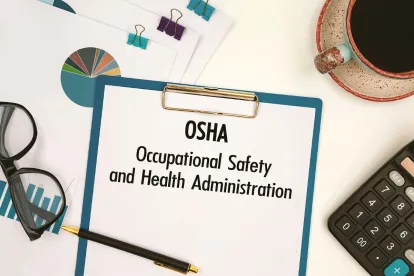Unless you’ve been living under a rock, you know that OSHA issued its long-anticipated COVID-19 Vaccination and Testing Emergency Temporary Standard (ETS) at the end of last week. The ETS requires covered employers to either (1) develop, implement, and enforce a mandatory vaccination policy or (2) allow unvaccinated employees to test regularly and be subject to a mask policy. The ETS also contains COVID-specific recordkeeping, reporting, and training requirements. Most requirements in the ETS were set to go into effect by December 5. But by the time we finished reading the 154-page rule, the Fifth Circuit had stayed its implementation.
There is no doubt the legal landscape surrounding the ETS will have changed by the time you read this post. But regardless of what is happening in the courts, it is important for manufacturers to understand the scope and applicability of the rule. It could be back in effect as quickly as it stayed, and the compliance timelines, at least in the originally published rule, were tight.
General Applicability
Generally, the ETS applies to all private employers with a total of 100 or more employees at any time the ETS is in effect. There are several exemptions and nuances to this applicability. For starters, any employer already subject to one of the following requirements, is not covered by the ETS:
-
COVID-19 Workplace Safety: Guidance for Federal Contractors and Subcontractors;
-
OSHA Emergency Temporary Standard for healthcare employers; or
-
Centers for Medicare & Medicaid Services (CMS) Health Care Staff Vaccination rule.
In counting to 100, it is important to note that all employees are counted across all of the company’s locations in the United States. This includes part-time, seasonal, and work from home employees; those that do not report to a workplace; and those that work exclusively outdoors.
Mandatory Vaccination Policy or Testing/Masking Requirement
As promised, the ETS requires covered employers to either (1) require employees to be vaccinated, or (2) develop a testing program for unvaccinated employees that includes wearing face coverings. Employers choosing the mandatory vaccination option must allow employees to claim exemptions for disabilities, sincerely held religious beliefs, and medical necessity. Employers that opt for the testing/face covering option will be required to track the status of unvaccinated employees and their testing results, monitor face covering compliance, and determine whether the employer is responsible under other laws, regulations, or collective bargaining agreements to pay for the testing.
OSHA’s COVID-19 Vaccination and Testing ETS website has sample templates for both a mandatory vaccination policy and a vaccination or testing and face covering policy.
Regardless of the type of policy put in place, covered employers will be required to determine the vaccination status of each covered employee. Unlike the rules for determining whether you have 100 or more employees, for the vaccination determination requirement, covered employees do not include those that work from home, remotely, or exclusively outdoors.
Employers must provide accommodations for previously unvaccinated employees to get vaccinated, including up to 4 hours paid time, including travel time, at the employee’s regular rate of pay, as well as reasonable time and paid sick leave to recover from any side effects associated with the vaccinations.
Employers that choose mandatory vaccination will likely have a number of employees that qualify for one of the exemptions described above. In those instances, OSHA encourages the employer to find the safest work option, such as remote work. However, OSHA also assumes that many of these employees will be subject to testing to allow their employers to comply with the ETS. If so, an employer that chooses mandatory vaccination to avoid the logistical issues associated with testing might find themselves in that position anyway.
Information Requirements
Covered employers must provide each covered employee with information, in a language and at a literacy level that the employee understands, regarding:
-
the requirements of the ETS;
-
workplace policies and procedures established to implement the ETS;
-
vaccine efficacy, safety, and the benefits of being vaccinated (by providing the CDC document “Key Things to Know About COVID-19 Vaccines”);
-
OSHA’s protections against retaliation and discrimination; and
-
laws that provide for criminal penalties for knowingly supplying false statements or documentation.
Recordkeeping and Reporting
The ETS will also impose specific reporting obligations for COVID-19 fatalities and hospitalizations upon covered employers. These reporting obligations largely track employers’ existing reporting obligations found in 29 C.F.R. § 1904.39, except that, with regard to COVID-19 fatalities and hospitalizations, OSHA has eliminated the requirement that, to be reportable, the fatality must have occurred within 30 days and the hospitalization must have occurred within 24 hours of the work-related incident. Because COVID symptoms can be delayed, OSHA did not feel a temporal reporting restriction was appropriate.
While the timeline to comply with the ETS is in flux, it is important to stay on top of developments to ensure that you have sufficient time to react and be in compliance when and if the ETS takes effect.
Jonathan H Schaefer also contributed to this blog.



 />i
/>i
